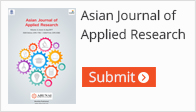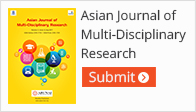THE EFFECT OF VISION TRAINING ON SELECTED VISUAL, HAND-EYE CO-ORDINATION AND OVERALL SOCCER PLAYING ABILITY OF UNIVERSITY LEVEL AND INTER-COLLEGIATE LEVEL SOCCER PLAYERS.
Dr.K.Jayaraja| Journal Title | : | Asian Journal of Multidisciplinary Research |
|---|---|---|
| DOI | : | |
| Page No | : | 1-5 |
| Volume | : | 1 |
| Issue | : | 3 |
| Month/Year | : | 3/2015 |
Keywords
Abstract
The Purpose of the study was to find out the effect of vision training on selected visual skills, Hand-eye co-ordination and overall Soccer playing ability of University level and Inter-collegiate level Soccer players. Three matched groups each having 22 males of 18 to 28 years of age served as subjects. the subjects were divided into three equal groups of Twenty two each. University level Soccer players (Experimental Group I) and Inter-Collegiate level Soccer players (Experimental Group II)and Group 111( Control Group ) due to the influence of twelve week period vision training on visual skills and group over all playing ability.. The training was given for twelve weeks, six days per week of two hours duration each in the morning and evening session. The University level Soccer players (Experimental Group I) and Inter-Collegiate level Soccer players (Experimental Group II) due to the influence of twelve week period vision training on visual skills and over all playing ability. Group-III. Analysis of Covariance, a statistical technique was used to test the adjusted mean difference result was statistically significant the Scheff’s post-hoc test was used to find out the paired mean differences of experimental group-I, experimental group –II and control group(Clarke and Clarke, 1972). The repeated measures of ANOVA was used to test the significant of mean difference over the progress of vision training on criterion measures. If the obtained F-ratio was significant, then Newman Keul’s test was used to find the paired mean difference between the measures of pretest and post test (Clarke and Clarke, 1972).


